Strategic Area
Energy Efficient Buildings and Communities
Status
Completed
Partners
- Hydro-Ottawa
- Hydro-Quebec
- Kruger Products LP
- SMi Enerpro
- Carleton University
- Viessmann Manufacturing Company Inc.
- Regulvar Inc.
- Trane Canada
- AddÉnergie Technologies Inc.
- Smardt Chiller Group
- Urecon Ltd
Fund
Energy Innovation Program
Year
2018
EIP Contribution
$1 M
Project Total
$5.4 M
Location
Gatineau, QC
Find out more
Lead Proponent
Zibi Community Utility LP (Services d’Énergie de Quartier Zibi SEC)
Project Background
The objective of the project was to implement the initial phase of a 4th-generation zero-carbon district thermal system, also known as a district or community energy system. A first of its kind in North America, the Zibi district thermal system (‘DTS’) recovers post-industrial waste heat from the adjacent Kruger tissue mill and uses it for space and water heating in the buildings of the Zibi development. Compared to district heating systems reliant on fossil fuels, the Zibi DTS provides a significant GHG reduction while keeping cost to residents similar to conventional gas heating.
The DTS extracts waste heat from the Kruger mill and moves it to the Zibi central plant. Leveraging large high-efficiency water-to-water heat pumps and inexpensive Quebec electricity, the low-grade heat is transformed to temperatures suitable for space and water heating, and the resulting thermal energy is circulated to the buildings of the Zibi development on both the Quebec and Ontario sides of the Ottawa River. Space conditioning is provided by in-suite heat pumps on the Quebec side and fan-coil units in Ontario. Domestic hot water is produced by in-building heat pump water heaters in Quebec, and from a higher-temperature hot water loop to the Ontario side.
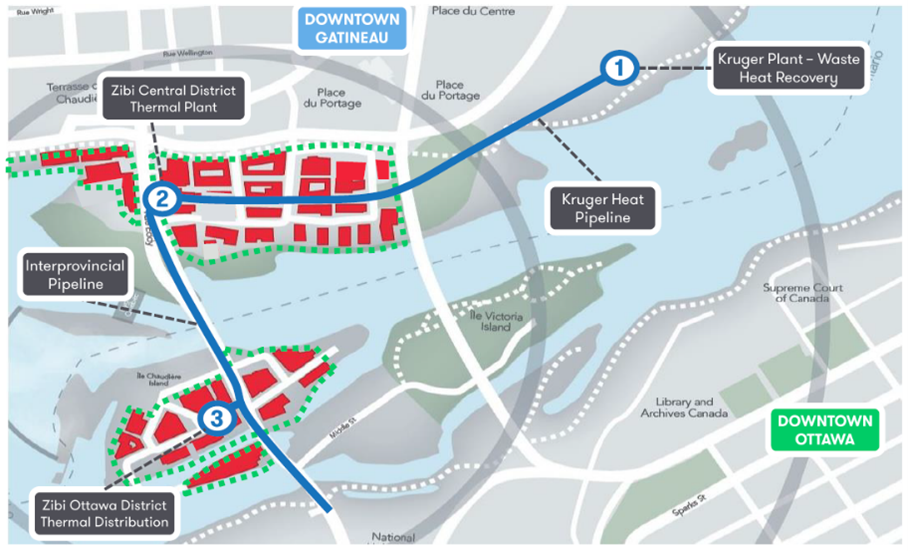
Fig.1: Map of the Zibi development showing the DTS central plant and connections on the Quebec and Ontario sides. (Zibi Community Utility)
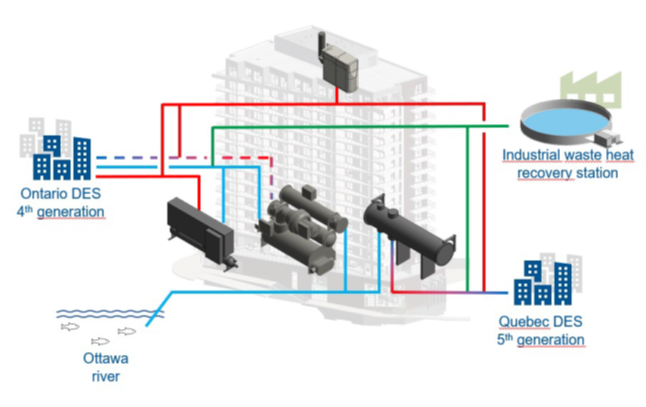
Fig.2: Schematic of the Zibi DTS showing the central plant equipment, different heating and cooling loops, and external connections. (Zibi Community Utility)
Phase 1 consisted of overall DTS design, construction and commissioning of a temporary central plant, and the installation of piping between the central plant, the Kruger mill, and the first buildings in the Zibi development. This early work was crucial for Zibi, proving the system concept and building confidence in their partners and funders to support further DTS expansion.
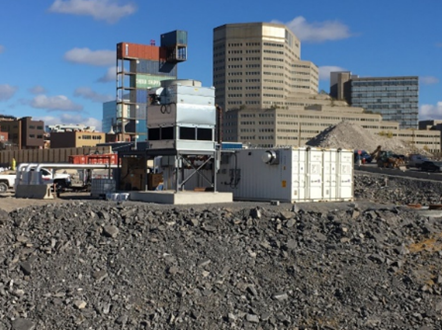
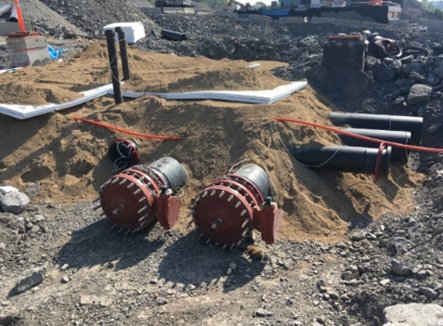
Fig. 3 Left: Zibi DTS temporary central plant in 2019, surrounded by the construction site that will become the Zibi development. Right: Underground piping installed at the Zibi site, which will form part of the DTS loops. (Scott Demark/Zibi Community Utility)
Results
“Without NRCan funding, there would be no Zibi DTS.”
Scott Demark
President, Zibi Community Utility
Phase 1 of the DTS was completed successfully in 2019, with the system working as intended. NRCan’s early funding and support for the project enabled Zibi to take the bold step of using the DTS to heat the first of Zibi’s buildings, avoiding the capital costs of (and GHG emissions from) temporary HVAC equipment. This arrangement provided the basis of the DTS business case, bringing Zibi’s long-term zero-carbon heating goal within reach.
The Project’s success led Zibi to continue the DTS expansion in scale and capability. In 2021, the permanent DTS central plant in the Aalto Building was completed and brought online. Designed to clearly showcase how the system functions, the plant features color-coded piping and signage to help guide frequent tour groups from industry and the public. At least 600 people have toured the plant so far including municipal planners, government officials, and industry professionals.
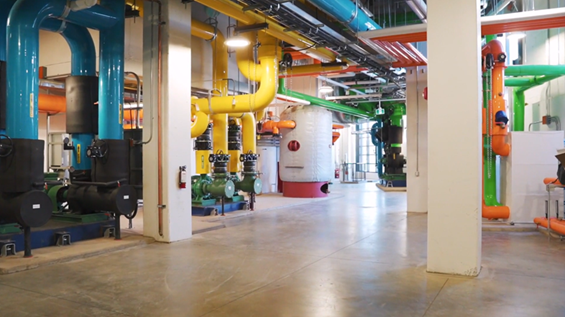
Fig. 4: Zibi Central Plant. The plant contains color-coded piping to highlight the heating and cooling loops, and the mechanical equipment required to operate the DTS.
Run-of-river cooling was also added, enabling Zibi to efficiently sink excess summer building heat into the Ottawa River. As of late 2024, the DTS is fully operational, serving 9 buildings with 1M sq.ft. of floor area, and is expected to operate at 100% zero-carbon going forward.
Benefits to Canada
In operation, the DTS is providing a permanent carbon reduction in the centre of Ottawa, which will increase year-over-year as buildings are added to the development. Zibi residents and commercial tenants will enjoy zero-carbon heating and cooling at similar cost to conventional gas heating. Zibi anticipates that the DTS will allow 41,000 tons/year of GHG emissions to be avoided by 2030.
The Project, and the DTS overall, has created local employment and economic benefits, including:
- Work in site remediation and construction.
- Training and employment in DTS operation and maintenance.
- Canadian clean-tech jobs in engineering and design.
- Spin-off products, IP, and related opportunities for the Project partners.
More broadly, the Zibi DTS serves as a replicable demonstration of recovering low-grade waste heat for use as a low-carbon source of heating or cooling energy for buildings. Aside from industrial operations, other potential sources of waste heat include large sewer lines, data centres, and large office buildings.
Inspired by Zibi’s approach, several projects are currently under design and/or construction in Montreal and Toronto aiming to use heat recovery chillers to extract and upgrade low-grade heat from main sewer lines to provide space heating.
Next Steps
The DTS continues to be built out in parallel with the Zibi development. As new buildings are completed, they will be connected to the DTS to supply their heating and cooling needs. When the development is fully built, currently anticipated in the 2030s, the DTS will provide 16MW of heating and 4500 tons of cooling capacity to approximately 2000 residential units and 2.4 million square feet of commercial space.
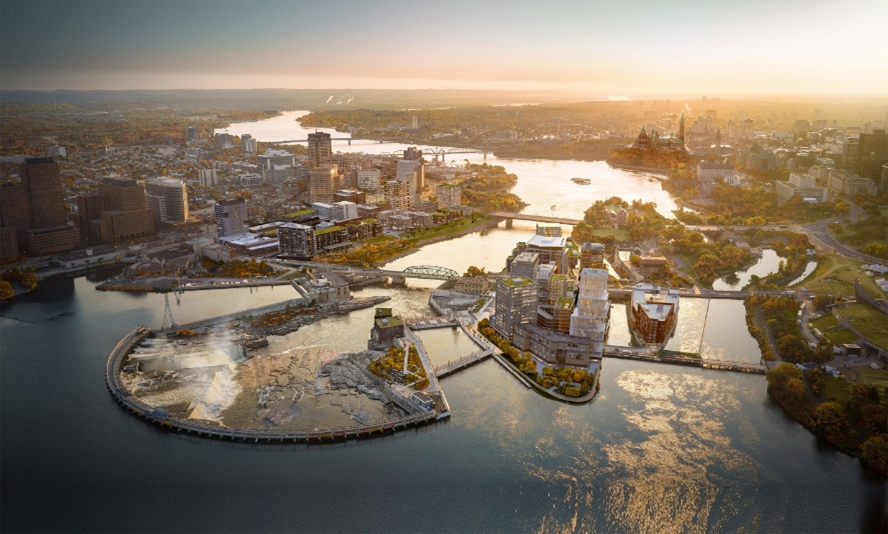
Fig. 5: Rendering of the complete Zibi development, anticipated in the 2030s. The Zibi DTS will continue to provide zero-carbon heating and cooling to buildings on both sides of the Ottawa River. (Norm Li/Dream)